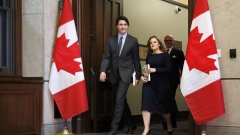Mar 5, 2024
Turkey Rate Hike Calls Resurface as Inflation Heats Up Again
, Bloomberg News

(Bloomberg) -- Investors are amping up the pressure on Turkey to resume interest-rate hikes as inflation spikes again, the lira weakens and foreign reserves dwindle.
With strong economic activity despite monetary tightening since an election last year, economists and traders say the policy stance, with the one-week repo rate at 45%, is still not tight enough to tame inflation. Swap traders are now pricing a 300 basis-point hike in April after a bigger-than-expected 67% surge in consumer prices in February.
On Monday, JPMorgan said it expects the central bank, which has been on hold since January, to raise its key policy rate by 500 basis points to 50% in April while revising its inflation forecast upward. Similarly, Goldman Sachs sees further tightening as possible and says policymakers would like to see some capital inflows after elections.
Under its latest outlook, Turkey’s central bank anticipates inflation will peak above 70% in May and end the year at 36%.
The central bank has raised the key rate by 3,650 basis points, or 36.5 percentage points, since May. In January it said the tightening cycles was over but then moved back to a more hawkish guidance under new governor Fatih Karahan, saying in February it will tighten policy “in case a significant and persistent deterioration in inflation outlook is anticipated.”
Turkish Treasury and Finance Minister Mehmet Simsek said earlier on Tuesday that rate-setters believe monetary policy is tight enough, though authorities still plan additional credit tightening and quantitative tightening steps.
Onur Ilgen, head of Treasury at MUFG Bank Turkey AS, even without further rate hikes, the market is at least anticipating that high rates should stay for a longer period than initially envisaged.
Morgan Stanley, meanwhile, has removed the two rate cuts it had previously penciled in for November and December, and now sees the first cuts only in the first quarter of 2025, the bank’s economist Hande Kucuk wrote in an emailed report on Tuesday.
The offshore 12-month forward implied yield — an indicator of offshore lira funding costs — has jumped to 60% on Tuesday. That’s the highest level since Simsek’s appointment last May and is signaling tighter liquidity conditions.
At the same time, forward contracts on dollar-lira have also surged, with the spread between six-month and one-month forwards on the currency pair hitting an all-time high. That reflects expectations for interest-rate differences to be wider than they currently are.
Moves in Turkey’s foreign exchange reserves and the lira are also adding to the pressure. Net foreign assets, an indicator of net reserves, have fallen by around $20 billion between end-December and March 1, official data shows. The lira has dropped 6.6% so far this year against the dollar, the worst-performing emerging-market currency after the Chilean peso.
Finally, the spread between the interbank and spot lira markets has been widening, a sign of rising demand for physical dollars. The lira is at around 32.5 against the US currency in the spot market of the Grand Bazaar in Istanbul, according to websites of exchange bureaus, compared with 31.6 in interbank trading.
(Updates with Morgan Stanley report in sixth paragraphs, updates prices throughout)
©2024 Bloomberg L.P.








